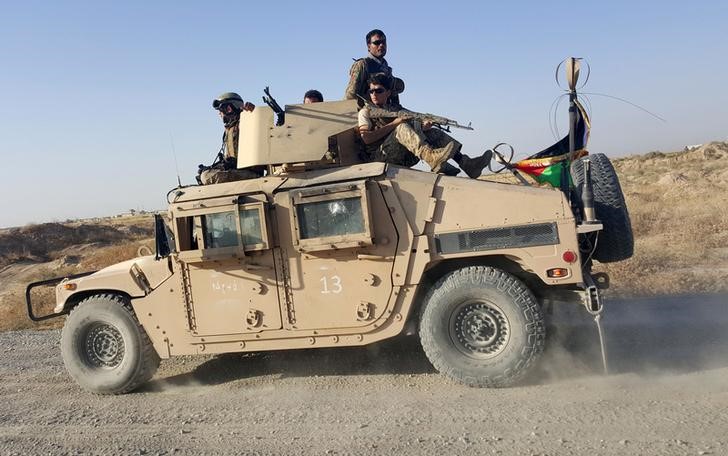By Hamid Shalizi
KUNDUZ, Afghanistan (Reuters) - Hungry and exhausted after being routed by Taliban fighters in the northern city of Kunduz, Afghanistan's army and police force are blaming each other for the shambolic surrender of the provincial capital.
The lack of coordination between the key pillars of Afghan security forces contributed to a humiliating loss, which, though largely reversed three days later, leaves the government looking more vulnerable than at any time during the 14-year insurgency.
"They were the ones who surrendered to the Taliban, not us," said soldier Aqa Shereen, referring to the city's police force. "Most of them are a bunch of cowards."
Shereen said he was forced to abandon a strategically important hill fort overlooking the city's main roads after running out of ammunition and food, three days after the majority of soldiers and police had retreated from the city center to regroup close to the airport.
His lips cracked from lack of food and water, and drained after four days with barely any sleep, Shereen told Reuters how he managed to escape to the army base next to the airport in a Humvee vehicle under enemy fire.
Abdul Karim, a police officer, said he was in a watch tower near the airport when the Taliban attacked in a later phase of the assault. He pinned the blame firmly on the army.
"The army has no guts to fight," Karim said, pointing to the watch tower riddled with bullet holes. "It was us who did the whole job."Sayed Zubair, another police officer, said the city had enough forces to defeat the Taliban, but there was a lack of coordination between the police, army and intelligence agencies.
"Look at the soldiers. Despite having modern weapons, they are soft and love to stay at their bases," he said.
WORRY FOR WASHINGTON
Whoever may have been to blame for the fall of Kunduz, the fact that soldiers and policemen are openly criticizing each other is an ominous sign for the government of President Ashraf Ghani, the NATO alliance and the administration in Washington.
U.S. President Barack Obama has pinned his hopes of a complete withdrawal of American troops from Afghanistan on training and equipping local forces to contain a growing insurgency by Taliban militants fighting to return to power.
From a peak of about 130,000, the NATO force dominated by U.S. troops is now less than a tenth of that size, focusing mainly on training and assisting Afghan forces.
The United States has spent around $65 billion in preparing the fledgling Afghan security forces of some 350,000 personnel for when it leaves.
Obama wants all but a few U.S. soldiers out of the country by the end of 2016, although the Taliban's audacious seizure of Kunduz means that deadline could come under review.
"For all the improvements that Afghan troops have made in recent years, the country's fighting forces remain a major work in progress," said Michael Kugelman, a senior associate for South and Southeast Asia at the Woodrow Wilson International Center for Scholars.
"And when your country faces an insurgency capable of seizing a big city, 'work in progress' is not good enough, and is, in fact, quite dangerous."
Col. Brian Tribus, spokesman for the NATO-led coalition, said they were working to improve coordination between the defense and home ministries because it was vital to Afghanistan's long-term security."We are confident, once operations in Kunduz are complete, the Afghan government will assess lessons learned from the incident and will take appropriate measures to address identified shortcomings," Tribus said.
The Taliban had laid siege to parts of Kunduz for several months, and government forces comfortably outnumbered the militants, making its capitulation all the more troubling.
Residents estimate the Taliban had hundreds of fighters, compared with about 5,000 government forces.
A ring of checkpoints protecting the city center was staffed by poorly equipped police, and, once Taliban fighters were inside, Afghan forces were reluctant to use heavier weapons for fear of inflicting civilian casualties.
SIGNS OF DISARRAY
First-hand accounts of the fall of Kunduz, now largely back under government control despite pockets of Taliban resistance, point to a fighting force plagued by disorganization, mismanagement and a shortage of battle-ready fighters.
First lieutenant Ahmad Reza said he and his colleagues were left without enough ammunition or food, and eventually abandoned altogether by their commanders.
Mohammad Anwar, another soldier, added: "The reason we didn't fight the Taliban is because most of the times other units who were supposed to back us up had already withdrawn.
"I wanted to go ahead and fight, but when we are surrounded, help won't arrive and you get killed."
Ghani recognizes his forces have struggled, and spoke on Thursday of the need to improve coordination and decision making and to root out corruption. Low morale is another key challenge.
"When people get phone calls and say 'abandon', that weakens morale. Morale is a fundamental issue and (to improve it is) one of our main tasks," he told reporters in Kabul.
According to local witnesses and officials, as Taliban fighters stormed Kunduz, soldiers and police officers fled their positions, leaving everything behind. In some cases that included their uniforms.
